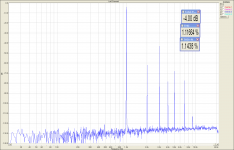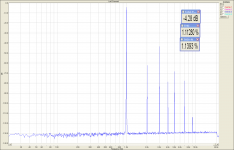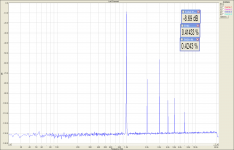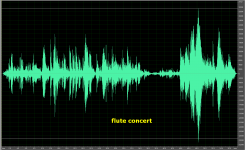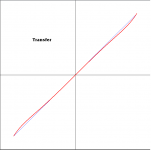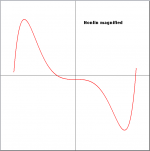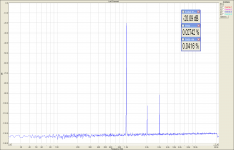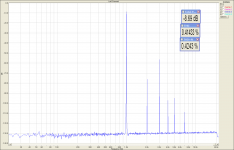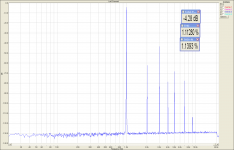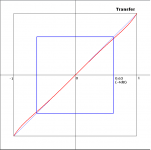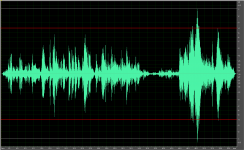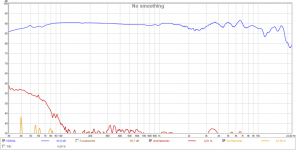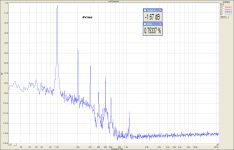Thanks to all who posted the results on sine tones.
I have prepared a test with real music. Distortion has been added mathematically, which is always a pain, because in the real speaker the distortion depends on frequency and higher amplitude may excite further distortion, non-harmonic. Both I am unable to simulate.
The distortion profile used is attached and applies only for amplitudes as in the plot. For smaller amplitudes, distortion is decreased, which is similar to normal speaker.
Test files are at
http://pmacura.cz/flute.zip
It is a flute concert and forte is in the second half of the sample.
Please try the files and in case of a positive abx result, please post it here. I can make everyone sure that this test will be much more difficult than those with the sines.
I have prepared a test with real music. Distortion has been added mathematically, which is always a pain, because in the real speaker the distortion depends on frequency and higher amplitude may excite further distortion, non-harmonic. Both I am unable to simulate.
The distortion profile used is attached and applies only for amplitudes as in the plot. For smaller amplitudes, distortion is decreased, which is similar to normal speaker.
Test files are at
http://pmacura.cz/flute.zip
It is a flute concert and forte is in the second half of the sample.
Please try the files and in case of a positive abx result, please post it here. I can make everyone sure that this test will be much more difficult than those with the sines.
Attachments
Last edited:
I would like to say I got a positive result (I did) but I couldn't repeat the trick  The following tests I ran gave a 6/8 and then a 5/8. Maybe fatigue was setting in.
The following tests I ran gave a 6/8 and then a 5/8. Maybe fatigue was setting in.
Code:
foo_abx 2.0.4 report
foobar2000 v1.3.16
2017-11-14 18:23:00
File A: flute distorted.wav
SHA1: 2fb3327e56efb5a10ec5783b4cc3848b56a29be8
File B: flute.wav
SHA1: acef85edba0a2bc1b5ae970763d8f5ea389bd98a
Output:
DS : Primary Sound Driver
Crossfading: NO
18:23:00 : Test started.
18:23:25 : 00/01
18:23:58 : 01/02
18:24:11 : 02/03
18:24:35 : 03/04
18:24:45 : 04/05
18:24:55 : 05/06
18:25:07 : 06/07
18:25:18 : 07/08
18:25:18 : Test finished.
----------
Total: 7/8
Probability that you were guessing: 3.5%
-- signature --
40234b358700d19b12d8ff2107952ba7264471c1
Code:
foo_abx 2.0.4 report
foobar2000 v1.3.16
2017-11-14 18:31:11
File A: flute distorted.wav
SHA1: 2fb3327e56efb5a10ec5783b4cc3848b56a29be8
File B: flute.wav
SHA1: acef85edba0a2bc1b5ae970763d8f5ea389bd98a
Output:
DS : Primary Sound Driver
Crossfading: NO
18:31:11 : Test started.
18:31:58 : 01/01
18:32:15 : 02/02
18:32:27 : 02/03
18:32:39 : 03/04
18:32:54 : 04/05
18:33:07 : 05/06
18:33:17 : 05/07
18:33:35 : 06/08
18:33:35 : Test finished.
----------
Total: 6/8
Probability that you were guessing: 14.5%
-- signature --
068f88e392ef9b1f4024f2be23591b2b4899a37dWell, this should settle the matter. Scott and Geddes and any others who dont seem to believe one can hear much of anything in the way of distortion.
Sine waves are not music and speakers do not have constant distortion with level or frequency. I do see JBL does not see fit to make that information readily available. Carry on with this if it makes you happy.
speakers do not have constant distortion with level
We do not test on constant distortion with level.
Attachments
We do not test on constant distortion with level.
You'll have to convince me there exist (serious) speakers that are expansive and compressive. Not to say there aren't any but how about monotonically decreasing non-linearities before the exotic stuff.
Well, this should settle the matter. Scott and Geddes and any others who dont seem to believe one can hear much of anything in the way of distortion. I would guess they have not spent much time critically listening.
Dick you should go to Burning Amp sometime, I'm sure you would be a big hit.
You'll have to convince me there exist (serious) speakers that are expansive and compressive. Not to say there aren't any but how about monotonically decreasing non-linearities before the exotic stuff.
The test music sample amplitudes are in the decreasing portion of the nonlinearities, of the nonlinear transfer curve, as you have probably noticed in the post 45
Audibility of speaker nonlinear distortion - test
This thread I opened mostly on your request in another thread, asking me to post some proof of speaker nonlinear distortion audibility.
Last edited:
You'll have to convince me there exist (serious) speakers that are expansive and compressive. Not to say there aren't any but how about monotonically decreasing non-linearities before the exotic stuff.
Almost the whole flute concert music sample has amplitude less than -4dBFS, except for one short drum passage near time of 48s, you can see it attached. The transfer function used in the test is definitely monotonically decreasing for amplitudes equal and smaller than -4dBFS. This can be seen from the transfer curve plot and also from harmonic distortion plots taken at amplitudes -4dBFS, -8dBFS and -20dBFS approx.
I was asking Mooly which part of the concert he was listening to in his ABX, and he answered that the flute part, so he was definitely well below -4dBFS, where the transfer curve nonlinearity is monotonically decreasing, as you are asking for.
Attachments
Last edited:
Generally speaking, I am disappointed that the thread has reverted into personal attacks. Though I understand it is much easier than the real work, I would appreciate more constructive approach and I thank to those who have participated and are participating in the tests.
Please carry on. Although I cannot always keep up with the level of understanding here Im hopful for it all to shake down to useful info.
BTW there can be a fine line between those whos intent is less than noble and those who are simply digging with some passion. Sometimes its hard to tell the difference, even within ourselfs
As iron sharpens iron....
I'm sorry but no luck this time.
I can get 9/12 the best.
The more auditions I hear more similar are the tracks.
Seems to me my brain invented the distortion on the non distorted track
For me I think this could be the threshold for a clearly discernment.
What about summing the distortions? Maybe we can discern it if summing non discernible crossover distortion alone.
I can get 9/12 the best.
The more auditions I hear more similar are the tracks.
Seems to me my brain invented the distortion on the non distorted track
For me I think this could be the threshold for a clearly discernment.
What about summing the distortions? Maybe we can discern it if summing non discernible crossover distortion alone.
I think 9/12 is not bad at all, considering the tiny difference between the files.
This is the nonlinear difference between the files (linear shifts suppressed), without additional amplification. Some more audible sounds are only at the end of the file..
http://pmacura.cz/flutedist.zip
This is the nonlinear difference between the files (linear shifts suppressed), without additional amplification. Some more audible sounds are only at the end of the file..
http://pmacura.cz/flutedist.zip
My appologies Pavel I felt I was defending the speaker building DIY community. As for my technical issues let me clarify. The displacement of a speaker monotonically decreases with frequency. A frequency independent distortion can not match any reality, as well as the fact that very few speakers are single full range. This is a plot of Sennheiser headphones, falling rapidly with frequency. I'm fairly sure this whole flap arose partially around a fundamental misunderstanding , the highest THD numbers being thrown around almost certainly refer to high bass SPL's and the woofer distortion.
The mathematical creation of this behavior is far harder to do.
The mathematical creation of this behavior is far harder to do.
Attachments
To be fair, I think that Earl is on recent record here saying that speaker low level distortion is audible on pure tones, but not in music playback.
That would be the next step in the test, music playback of the same device where the sine distortion is easily heard.
Remember some years ago when Art did a huge series of horn driver tests?
He also characterizes it within the context of a modern low distortion system. Many systems are undersized IMO and thus have vastly higher nonlinear distortion than a geddes system or other systems with high output capability and good drivers.
Interesting work nevertheless. I find that the value in hifi is often in the subconscious- an improvement means I listen to more music as I recognize an improvement subconsciously, where it might be more difficult to perceive when trying. When I used to listen for the real subtle stuff I'd have to meditate before blind testing, but when I could reliably tell the difference, the best device in practice meant a more enjoyable listening experience. Now I focus on if things "feel" better and make me listen to more music. If so, it's generally good (and I recognize that that's a method fraught with perception biases).
My appologies Pavel I felt I was defending the speaker building DIY community. As for my technical issues let me clarify. The displacement of a speaker monotonically decreases with frequency. A frequency independent distortion can not match any reality, as well as the fact that very few speakers are single full range. This is a plot of Sennheiser headphones, falling rapidly with frequency. I'm fairly sure this whole flap arose partially around a fundamental misunderstanding , the highest THD numbers being thrown around almost certainly refer to high bass SPL's and the woofer distortion.
The mathematical creation of this behavior is far harder to do.
I agree that speaker distortion is highest at low frequencies up to 200Hz and I was fair enough not to put 50, 100 and 200Hz waves recorded from speakers to this test, though I have all of them measured and recorded. I am also sure you are aware of my measurements of speaker distortion comparing voltage drive and current drive.
Current drive of speakers and speaker distortion
The only reduction of distortion was found for a woofer in a closed box.
Unfortunately I am not able to simulate frequency dependent nonlinear transfer curve. So I took a midrange distortion as a basis for my experiment, which I consider fair. With hugely enlarged distortion from the woofer the result of the test might have been much worse, i.e. much more audible.
I do not feel like defending group X or group Y, I am just interested in explanations and understandings of our hearing.
Last edited:
Despite that, 100Hz test added, at 4Vrms.
http://pmacura.cz/speaker100.zip
I assume it would not be as easy as it might look like. Please do not use small PC speakers which would suppress the 100Hz frequency due to their LF roll-off.
http://pmacura.cz/speaker100.zip
I assume it would not be as easy as it might look like. Please do not use small PC speakers which would suppress the 100Hz frequency due to their LF roll-off.
Attachments
Last edited:
- Status
- This old topic is closed. If you want to reopen this topic, contact a moderator using the "Report Post" button.
- Home
- Loudspeakers
- Multi-Way
- Audibility of speaker nonlinear distortion - test
